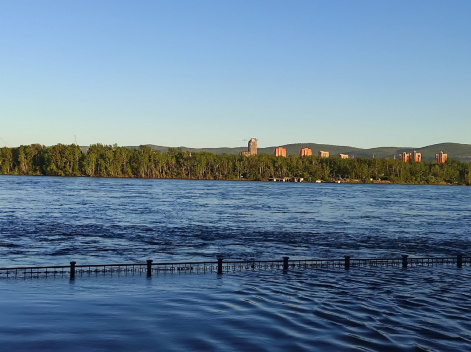A scientist of KSC SB RAS told about the relationship between deforestation and floods
10 June 2021 г.

According to RusHydro, exceptionally strong floods on the Yenisei occur once every 100 years. The reason for this flooding is the superposition of two weather factors. The amount of precipitation this year was almost three times higher than the norm. At the same time, high temperatures towards the end of May led to the rapid melting of snow in the mountains. According to the news agency Vesti.Krasnoyarsk, at the station Olenya Rechka in the south of the Krasnoyarsk Region, snowpiles shrank by almost a third in a week, which means that almost 800 thousand liters of water from each hectare of mountain slopes entered the Yenisei river basin in just seven days.
However, there is another factor affecting the water flow into the river channel, that is forest. It is known that each tree holds up to three hundred liters of water. Some media outlets emphasized concerns that the heavy flood could be associated with deforestation. How much tree cutting affects the accumulation and retention of water in the taiga, and whether there is a connection between deforestation and the current flood, these are the questions clarified by the director of the V.N. Sukachev Institute of Forest KSC SB RAS, Doctor of Biological Sciences, Alexander Onuchin:
“Forests play a water regulating role. We have developed and advanced the concept of a geographically determined hydrological role of forests. This means that the forests which grow in the south of the boreal zone or in the temperate zone, the central and southern European part of Russia and western Europe, function as vaporizers. These are very efficient ecosystems which can evaporate most of the precipitation. In general, if to talk about the impact on the amount of the annual runoff, the forests reduce it. At the same time, boreal forests, for example, typical for the Putorana plateau, and forest-tundra zone, on the contrary, accumulate moisture. The annual runoff from forest catchments in the north will always be greater than in the south. But this hydrological role is quantitative, and there is still a qualitative one. Forests regulate the runoff: like a sponge they absorb moisture and gradually release it. This can be seen at an example of the studies performed in mountain forests in Kyrgyzstan. In wet years, the runoff is greater from treeless catchments, and in dry years, on the contrary, it is more significant from forest catchments. The forest plays a very important water-regulating role, and it may even be more important than its drainage function.
To preserve the functions of the forest, it is necessary to correctly use it. In terms of forest management, we need to come to a sustainable forest management system. We apply a model of extensive use and reforestation. It is based on pioneer deforestation: we cut down the best and most accessible forests. At one time, Sweden also pursued this way, they cut down all their pine forests and, as a result, were left with a large deficit of forest resources. Then, they had reforestation systems and sustainable forest management systems. This means that one does not need to cut down more than it grows. It is necessary to allocate a part of the area for plantations, grow a forest there for a designated purpose and then, to use this forest. In this case, we will not have a shortage of forest resources. We are still far from this, and we still have a dominant model of extensive forest development.
I must say that the authorities have paid attention to this, and more emphasis is being placed on reforestation. But reforestation means planting a forest, especially with a closed root system. Firstly, it is not always efficient and not everywhere. The forest recovers well after restoration measures. Planting is not synonymous with reforestation; the forest needs care up to the age of maturity. This includes thinning and thinning so that the forest grows healthy and gives the desired result, whether these are carbon polygons, or protective forests, or even these are plantations for growing high quality wood.
If to talk about the flood situation, the role of forests is not so significant here. Forests will not be able to regulate it significantly. The forest can regulate the flood in a small catchment area. As for large rivers, the snow melts at different time and in different altitudinal zones. Depending on weather conditions and other factors, runoffs can overlap each other, or, on the contrary, can be dispersed. It turns out that for large rivers, the role of the forest in reducing floods is regulated by other factors, such as geographic ones or landscape. "
Source: KrasNews
Share:
